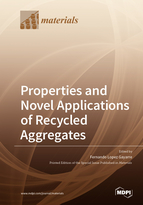Properties and Novel Applications of Recycled Aggregates
A special issue of Materials (ISSN 1996-1944). This special issue belongs to the section "Construction and Building Materials".
Deadline for manuscript submissions: closed (31 May 2020) | Viewed by 38942
Special Issue Editor
Interests: sustainable construction materials; recycled aggregates; concrete technologies; ultra-high-performance concrete; computational modeling of concrete
Special Issues, Collections and Topics in MDPI journals
Special Issue Information
Dear Colleagues,
The aggregates used in construction are the natural resource more consumed in the world after the air and water. Due to the overexploitation, all the environmental laws reward the use of recycled materials to guarantee the reduction of the consumption of natural aggregates. The use of reclaimed aggregates, reused aggregates and recycled aggregates increase the sustainability in the construction activities. Nowadays, they are strategic materials in the manufacturing of green concrete and mortars and as road construction eco-efficient materials. In addition, the use of recycled aggregates from industrial or mining by-products present great potential in the construction activities as recycled aggregates and/or supplementary cementitious materials.
This Special Issue is open to new experiences in construction materials and/or works made with recycled aggregates, including:
-Reclaimed aggregates from returned concrete waste from the washed of the mixer truck (reclaimed aggregates);
-Recycled concrete aggregates from crushed old concrete of construction and demolition waste;
-Recycled ceramic aggregates from brick and tiles waste and/or ceramic sanitary waste;
-Recycled mixed waste of concrete and ceramic waste from construction and demolition waste;
-Recycled glass aggregates from cullet glasses;
-Recycled plastic aggregates from plastic waste, for example, recycled polycarbonate particles waste from electric wires;
-Recycled aggregates from iron and steel industry waste (granulated blast furnace slag, electric furnace slag, Steel furnace slag);
-Recycled aggregates from processed scrap tires like tire chips and crumb rubber;
-Fly ash;
-Furnace bottom ash and incinerator bottom ash;
-Recycled mine aggregates from mine waste (coal washer rejects, fluorite waste, granite cutting waste, etc);
-Others recycled aggregates like rice husk, woodchip, etc.
Prof. Fernando Lopez Gayarre
Guest Editor
Manuscript Submission Information
Manuscripts should be submitted online at www.mdpi.com by registering and logging in to this website. Once you are registered, click here to go to the submission form. Manuscripts can be submitted until the deadline. All submissions that pass pre-check are peer-reviewed. Accepted papers will be published continuously in the journal (as soon as accepted) and will be listed together on the special issue website. Research articles, review articles as well as short communications are invited. For planned papers, a title and short abstract (about 100 words) can be sent to the Editorial Office for announcement on this website.
Submitted manuscripts should not have been published previously, nor be under consideration for publication elsewhere (except conference proceedings papers). All manuscripts are thoroughly refereed through a single-blind peer-review process. A guide for authors and other relevant information for submission of manuscripts is available on the Instructions for Authors page. Materials is an international peer-reviewed open access semimonthly journal published by MDPI.
Please visit the Instructions for Authors page before submitting a manuscript. The Article Processing Charge (APC) for publication in this open access journal is 2600 CHF (Swiss Francs). Submitted papers should be well formatted and use good English. Authors may use MDPI's English editing service prior to publication or during author revisions.







